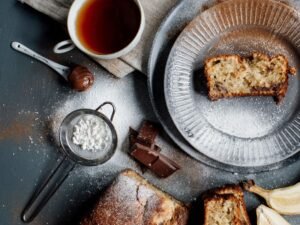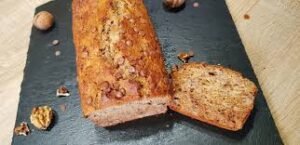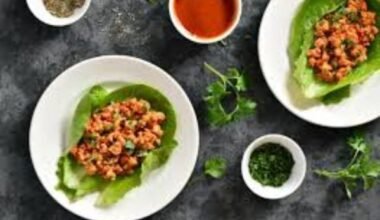There’s something undeniably comforting about a slice of warm, moist banana bread. Whether enjoyed as a breakfast treat, an afternoon snack, or a dessert, banana bread has secured its place as a beloved staple in home baking. What makes this recipe stand out is the use of oil instead of butter, ensuring an exceptionally tender and moist crumb that stays fresh for days. Unlike butter, which can sometimes lead to a denser texture, oil distributes moisture evenly, creating a light yet rich loaf that melts in your mouth.
Banana bread is also a fantastic way to use up overripe bananas that might otherwise go to waste. The natural sweetness of ripe bananas means you can often reduce the amount of added sugar, making this treat a slightly healthier option without sacrificing flavor. Plus, the simplicity of the recipe means even novice bakers can achieve fantastic results with minimal effort.
In this article, we’ll explore the secrets to making the perfect moist banana bread with oil, including ingredient choices, mixing techniques, and baking tips. We’ll also discuss variations and add-ins to customize your loaf, ensuring it becomes a go-to recipe in your kitchen. Whether you’re a seasoned baker or just starting, this guide will help you create banana bread that’s irresistibly soft, flavorful, and perfectly moist every time.
The History of Banana Bread
Banana bread as we know it today became popular in the 1930s, thanks to the widespread availability of baking soda and baking powder, as well as the Great Depression, which encouraged home cooks to avoid waste. Overripe bananas, which would otherwise be thrown away, became a key ingredient in this economical yet delicious quick bread.
Before that, bananas were primarily eaten fresh, and recipes for banana-based baked goods were rare. Early versions of banana bread appeared in cookbooks in the late 19th century, but it wasn’t until the 20th century that it became a household staple. Today, banana bread remains a symbol of comfort and resourcefulness, with countless variations enjoyed worldwide.

Choosing the Right Ingredients
The foundation of any great banana bread lies in its ingredients. Using overripe bananas is non-negotiable—the darker the peels, the sweeter and more flavorful the bread will be. These bananas mash easily and blend seamlessly into the batter, distributing their natural sugars throughout the loaf. For the oil, a neutral-flavored option like vegetable, canola, or coconut oil works best as it won’t overpower the banana flavor. Coconut oil adds a subtle richness, while vegetable oil keeps the taste purely banana-forward.
Flour selection also plays a role in texture. All-purpose flour is the standard choice, but for a slightly denser, nuttier loaf, whole wheat flour can be used in partial substitution. Leavening agents like baking soda and baking powder ensure the bread rises properly, while a touch of salt enhances all the flavors. Eggs act as a binder, and vanilla extract adds depth. For sweetness, granulated sugar or brown sugar can be used—brown sugar introduces a hint of molasses, complementing the bananas beautifully.
The Perfect Mixing Technique
Overmixing is the enemy of tender banana bread. To achieve the ideal texture, mix the wet and dry ingredients separately before gently combining them. Start by mashing the bananas thoroughly—some small lumps are fine, as they’ll add pockets of flavor. Whisk in the oil, eggs, and vanilla until just incorporated. In a separate bowl, sift together the dry ingredients to prevent clumping and ensure even distribution.
When combining the wet and dry mixtures, use a spatula and fold gently until no flour streaks remain. A few lumps in the batter are perfectly fine; overworking it will develop gluten, leading to a tough, chewy loaf. If adding mix-ins like nuts or chocolate chips, fold them in last. This method guarantees a light, airy crumb while keeping the bread moist and flavorful.
Baking for Optimal Moisture
The baking process is just as crucial as the preparation. Preheat your oven properly—around 350°F (175°C)—to ensure even cooking. A loaf pan lined with parchment paper or lightly greased prevents sticking and makes removal effortless. Pour the batter into the pan and smooth the top for an even rise.
Bake until a toothpick inserted into the center comes out clean or with a few moist crumbs—about 50-60 minutes, depending on your oven. Avoid overbaking, as this will dry out the bread. Let the loaf cool in the pan for 10 minutes before transferring it to a wire rack. This allows the structure to set without trapping steam, which can make the bread soggy.
Customizing Your Banana Bread
One of the best things about banana bread is its versatility. For added texture, fold in chopped walnuts, pecans, or chocolate chips. A swirl of cinnamon sugar or a drizzle of caramel before baking can elevate the flavor profile. For a healthier twist, substitute part of the flour with oats or almond flour, or reduce the sugar slightly if your bananas are very ripe.
Spices like cinnamon, nutmeg, or cardamom add warmth, while a handful of shredded coconut or dried fruit introduces new layers of taste. For an indulgent touch, a cream cheese swirl or a streusel topping can transform your banana bread into a decadent dessert. The possibilities are endless, allowing you to tailor the recipe to your preferences.
Storing for Freshness
To keep your banana bread moist for days, store it properly. Once completely cooled, wrap it tightly in plastic wrap or aluminum foil and keep it at room temperature for up to three days. For longer storage, slice and freeze individual portions, reheating them as needed. Avoid refrigeration, as it can dry out the bread.
The Science Behind Moist Banana Bread
Understanding the science behind baking can help you perfect your banana bread recipe. The moisture in banana bread primarily comes from the bananas themselves, which are about 75% water. When combined with oil, which is 100% fat, the liquid and fat work together to create a tender texture. Unlike butter, which contains water and can sometimes lead to gluten development, oil coats the flour proteins more thoroughly, inhibiting gluten formation and resulting in a softer crumb.
The ripeness of the bananas also affects the bread’s sweetness and moisture. Overripe bananas have higher sugar content due to the breakdown of starches, which not only enhances flavor but also helps retain moisture. The natural pectin in bananas acts as a binder, contributing to the bread’s structure without making it dense. Additionally, the Maillard reaction—the chemical process that occurs when sugars and proteins are heated—gives banana bread its beautiful golden-brown crust and deep, caramelized flavor.
Eggs play a dual role: the yolks add richness and fat, while the whites provide structure. Baking soda reacts with the acidic components in the batter (like bananas) to create carbon dioxide, which helps the bread rise. Understanding these interactions allows you to tweak the recipe for the perfect balance of moisture, sweetness, and texture.

Troubleshooting Common Banana Bread Issues
Even the best bakers encounter problems sometimes. If your banana bread turns out dry, it may be due to overbaking, too much flour, or not enough fat. To fix this, check your oven temperature with a thermometer to ensure accuracy, and measure flour using the spoon-and-level method to avoid packing too much into your cup. If the bread is too dense, you may have overmixed the batter or used too many bananas, which can weigh it down.
If your banana bread sinks in the middle, it could be because the batter was too wet, the oven temperature was too low, or the bread wasn’t baked long enough. To prevent this, make sure your bananas are well-mashed but not overly watery, and always test for doneness with a toothpick before removing the loaf from the oven. If the top browns too quickly while the inside remains undercooked, tent the loaf with aluminum foil halfway through baking to slow down browning.
Vegan and Allergy-Friendly Variations
For those with dietary restrictions, banana bread can easily be adapted. To make a vegan version, replace eggs with flax eggs (1 tbsp ground flaxseed + 3 tbsp water per egg) or applesauce. Plant-based milk can be used if the recipe calls for any liquid dairy, and the oil already makes it dairy-free. For a gluten-free option, substitute all-purpose flour with a gluten-free blend or almond flour, though the texture may be slightly denser.
If you’re reducing sugar, the natural sweetness of ripe bananas often means you can cut the added sugar by half without sacrificing flavor. For an oil-free version, unsweetened applesauce or mashed avocado can be used as substitutes, though the texture will be less rich. These variations ensure everyone can enjoy a slice of moist banana bread, regardless of dietary needs.

Serving Suggestions
While banana bread is delicious on its own, there are countless ways to serve it. For breakfast, toast a slice and spread it with peanut butter, almond butter, or a drizzle of honey. A dollop of Greek yogurt and fresh berries make it a balanced morning meal. For dessert, warm it up and serve with a scoop of vanilla ice cream or a drizzle of caramel sauce.
Banana bread also pairs wonderfully with coffee or tea, making it a perfect afternoon snack. For a brunch spread, slice it into thick pieces and serve alongside other baked goods like muffins or scones. If you’re feeling creative, use leftover banana bread to make French toast or bread pudding for a decadent twist.
Conclusion
Moist banana bread made with oil is a timeless classic that combines simplicity with irresistible flavor. By understanding the role of each ingredient and mastering the techniques, you can bake a loaf that’s perfectly tender, sweet, and satisfying every time. Whether you stick to the traditional recipe or experiment with add-ins and variations, this versatile treat is sure to please.
From its humble beginnings as a way to use up overripe bananas to its status as a beloved homemade staple, banana bread has earned its place in baking history. Its comforting aroma and delicious taste make it a favourite for all ages, and its adaptability ensures it never gets boring. With this comprehensive guide, you’re equipped to bake the best banana bread possible—one that’s moist, flavorful, and utterly irresistible.
So next time you spot those speckled bananas on your counter, don’t hesitate. Whip up a batch of this moist banana bread with oil, and enjoy the warmth and satisfaction that comes from baking something truly delicious. Happy baking!







